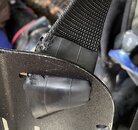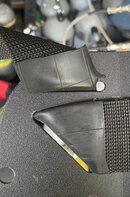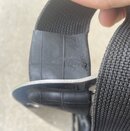Bear in mind that at the end, what will provide all the support while diving is the belt/crotch strap... that's where the magic happens...love my backplate... your's looks perfectly normal....
I agree with this.
The shoulder straps are there to prevent it from sliding left and right. The waist strap and crotch strap are there to hold it from moving up and down.
If the shoulder straps were tight enough to be snug on you while in the water, they’d be too small for you to get in or out of them. They have to be loose enough for you to get the rig on and off while seated on a boat bench, with huge dry glove cuffs. That isn’t that big, but there has to be a certain amount of length, and it will be more than you would need to hold it on your shoulders once it’s on.
Unlike most backpacks, these straps are not adjustable once you have them on, so you can’t tighten them when you’re done. So you’ll have to aim for that happy medium: as tight as reasonably possible while still being able to get into them. You will know if they are too loose if when you are in the water you tip to the side and the tanks shift on your back at your shoulders. If they do, you need to tighten your straps.
One other tip: make sure your waist strap is tight. And often, that means re-tightening your waist strap after you get in the water. Once the water compresses everything a bit, things shift around somewhat, etc., your waist strap will be too loose. That means everything will shift at that point. I make it part of my in-the-water beginning-of-dive process to just give my waist strap a bit of a tighten. Works for me.
ETA: I found out the hard way the role of straps in my advanced wreck class. There is a tricky hole the instructor takes students through which requires you to go completely sideways in order to get in through the hole: you and your tanks are now next to each other relative to gravity, and the tanks can slide much more easily. I couldn’t do it, because my tanks would shift just enough to be able to prevent me from wiggling through. I had previously had the straps adjusted for my dry suit, but was in my wetsuit for this dive, so they were literally like an inch or two longer than they should have been. My instructor also pointed out that if I had tightened my waistband at that point, I might have been able to secure things enough to make it through that hole. Like most things in advanced diving, the difference between success and failure often comes down to small details in the margins.
As for wear on the straps: I disagree with people who say it’ll take 1000 dives before you wear into the strap. Maybe I just have poorly manufactured plates, but I have multiple plates, and and all of them will begin to wear into the strap after mid double digit dives. I have two suggestions for that:
One, I use a piece of mountain bike tubing over top the strap in the areas where it goes through the plate. Something like 6 inches of tubing for each of the shoulder spots and a little less for each of the waist spots. it also helps to hold everything in place a bit. Of course, you will wear through the mountain bike tubing, but you just replace it before it begins to wear into the strap.
Two, make peace with your strap getting worn. After you replace the bicycle tubing a couple of times, you’re likely to get lazy because you just don’t want to be bothered with restringing a harness again. In which case, your straps will get chewed up. Oh well. Somewhere well north of 100 dives you’ll need to replace the strap. Again, oh well: the best strap in my opinion is the Halcyon webbing, so it’ll cost you something like 30 bucks to replace the shoulder webbing. So it’s like 30 cents a dive. I’ve made peace with it.

ETA2: anyone got a source for generic webbing that matches the supple/stiff characteristics of the Halcyon webbing? My cheapskate heart loves the idea of buying the webbing for less money, but I’d even buy it for the same price so that I didn’t look like a walking billboard with all those H’s on it. (having said that, I actually do find the H’s useful: they let me know if my waist strap is twisted, and it makes lining things up on the harness very quick and easy. I just hate looking like an advertisement.)






